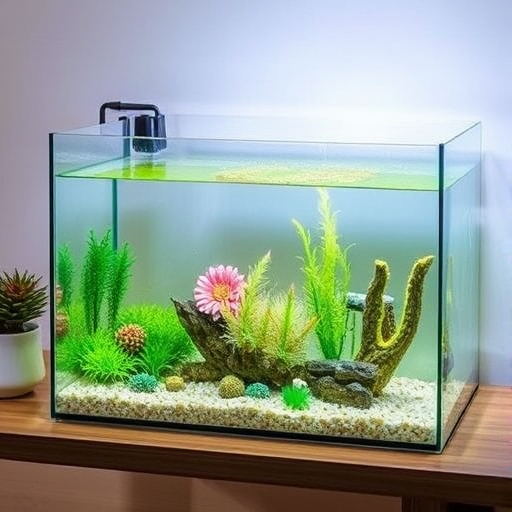How to Get Algae Off Aquarium Decor
Keeping an aquarium is a rewarding hobby that brings nature into your home. However, it also comes with its challenges—one of the most common being algae growth on aquarium decor. Algae can be unsightly and, if left unchecked, can harm the overall health of your aquarium. In this article, we will explore various methods to remove algae from aquarium decor, tips for preventing its growth, and answers to frequently asked questions.
Understanding Algae in Aquariums
What is Algae?
Algae are simple, plant-like organisms that can thrive in a variety of aquatic environments. In aquariums, they come in various forms, including:
- Green algae (filamentous, spot, and blanket)
- Brown algae (diatoms)
- Red algae (cyanobacteria)
- Excess Nutrients: High levels of nitrates and phosphates can fuel algae growth.
- Light: Algae require light to photosynthesize. Too much light can lead to rapid growth.
- Poor Water Circulation: Stagnant water can lead to algae blooms.
- Infrequent Maintenance: Neglecting regular cleaning can allow algae to flourish.
- Soft-bristled toothbrush or sponge
- Razor blade (for glass surfaces)
- Bucket for waste
- Aquarium-safe cleaning cloth
- Algaecides: Available at pet stores, they can help reduce algae growth. Always choose products labeled as aquarium-safe.
- Hydrogen Peroxide: In small doses, it can be effective against algae. Use 1 part hydrogen peroxide to 10 parts water.
- Test First: Always test chemical treatments on a small area of decor first.
- Follow Instructions: Adhere strictly to the dosage and application instructions.
- Snails: Species like Nerite and Mystery Snails consume algae.
- Shrimp: Amano and Cherry Shrimp are known for their algae-eating habits.
- Plants: Fast-growing aquatic plants can compete with algae for nutrients.
- Water Flow: Water passes through a UV light chamber.
- Algae Destruction: The UV light kills microscopic algae and prevents blooms.
- Effective: Reduces free-floating algae.
- Chemical-Free: No need for harmful chemicals.
- Water Changes: Perform regular water changes (10-15% weekly) to reduce nutrient levels.
- Clean Filters: Ensure filters are clean and functioning properly to maintain water circulation.
- Monitor Light: Limit light exposure to 8-10 hours per day.
- Test Water: Regularly test for nitrates and phosphates.
- Feed Sparingly: Overfeeding can lead to excess nutrients in the water.
- Live Plants: Incorporate live plants that can compete with algae for nutrients.
- Balanced Fertilization: Use fertilizers that promote plant growth while minimizing algae.
While some algae are harmless and can even be beneficial, excessive growth can lead to problems such as oxygen depletion and unsightly tank conditions.
Causes of Algae Growth
Algae thrive in environments with:
Methods to Remove Algae from Aquarium Decor
Cleaning algae off aquarium decor involves a few different techniques, depending on the severity of the growth and the type of decor.
1. Manual Removal
Tools Needed
Steps
1. Turn Off Equipment: Turn off filters and heaters to minimize stress on fish.
2. Remove Decor: Carefully take out the affected decor items.
3. Scrub: Use a soft-bristled toothbrush or sponge to scrub off the algae. For glass surfaces, a razor blade can be effective.
4. Rinse: Rinse the decor in a bucket of aquarium water to avoid introducing harmful chemicals.
5. Replace Decor: Put the cleaned decor back into the aquarium.
2. Chemical Treatments
Chemical treatments can be effective, but they should be used with caution to avoid harming fish and plants.
Common Chemical Treatments
Precautions
3. Natural Remedies
Natural remedies can provide a more eco-friendly approach to algae control.
Options
4. UV Sterilizers
A UV sterilizer can be an effective long-term solution for controlling algae growth in your aquarium.
How It Works
Benefits
Preventing Algae Growth
Regular Maintenance
Nutrient Control
Plant Growth
Comparison of Algae Removal Methods
| Method | Effectiveness | Ease of Use | Cost | Environmental Impact |
|---|---|---|---|---|
| Manual Removal | High | Easy | Low | Low |
| Chemical Treatments | Moderate | Moderate | Varies | Moderate to High |
| Natural Remedies | Variable | Moderate | Varies | Low |
| UV Sterilizers | High | Moderate | High | Low |
FAQs
How often should I clean my aquarium decor?
It is generally advisable to clean your aquarium decor every 2-4 weeks, depending on the level of algae growth.
Are there any fish that eat algae?
Yes, certain fish species like Plecostomus, Siamese algae eaters, and some species of tetras can help keep algae levels in check.
Is it safe to use bleach to clean aquarium decor?
Using bleach is not recommended as it can be toxic to fish and plants. If you must use it, ensure you thoroughly rinse and dechlorinate the decor before returning it to the aquarium.
Can algae be harmful to my fish?
While some algae are harmless, excessive algae can lead to oxygen depletion and harbor harmful bacteria, making it potentially dangerous for your fish.
What should I do if algae keeps coming back?
If algae keeps returning, consider evaluating your tank’s lighting, nutrient levels, and maintenance routine.
Conclusion
Removing algae from aquarium decor is an essential part of maintaining a healthy and attractive aquarium. By understanding the causes of algae growth, employing effective removal techniques, and implementing preventive measures, you can keep your aquarium looking pristine. Whether you prefer manual cleaning, chemical treatments, or natural solutions, the key to success lies in regular maintenance and monitoring. With these strategies, your aquarium can thrive, providing a beautiful and healthy environment for your aquatic life.





